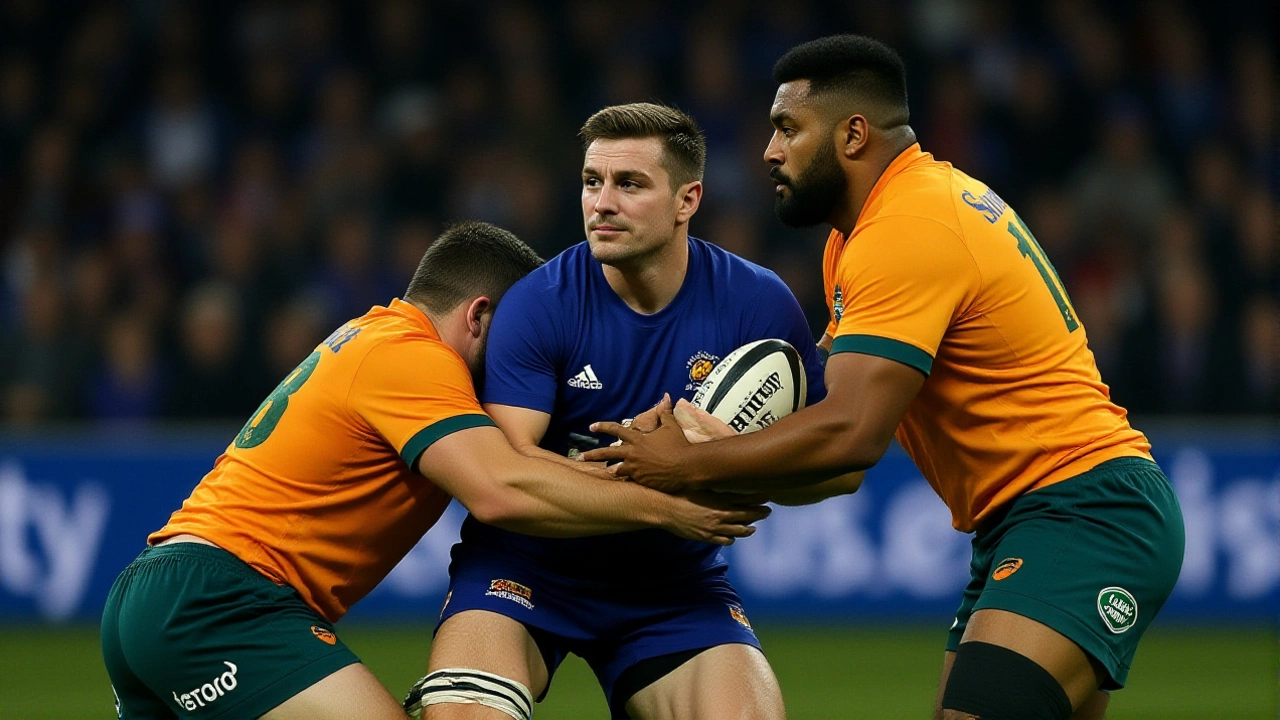France Stuns Wallabies 48-33 in Thrilling Stade de France Showdown
 Nov, 23 2025
Nov, 23 2025
On November 22, 2025, at 3:10 PM UTC, France national rugby union team delivered a brutal, breathtaking performance to crush the Australia national rugby union team (Wallabies) 48-33 at Stade de France in Saint-Denis. The win wasn’t just a result—it was a statement. With seven line breaks, relentless attacking pressure, and clinical finishing, France ended the Wallabies’ November tour with a winless record, extending Australia’s growing international crisis. This wasn’t a fluke. It was the culmination of months of structural decline Down Under—and a reminder that France, once again, is a force to be reckoned with ahead of the World Cup.
From Early Breakthrough to Dominant Finish
The match exploded out of the gate. At the two-minute mark, Wallabies prop Angus Bell burst through the French defensive line like a runaway train, setting up hooker Matt Faessler for the opening try. Fly-half Tane Edmed missed the conversion, a sign of things to come. But France responded with ruthless precision. Eight minutes later, Louis Bielle-Biarrey sliced through the Australian backline with a clean break, feeding winger Nicolas Depoortere for a try. Thomas Ramos, playing fullback and fly-half in tandem, nailed the conversion. The tone was set: France would attack from everywhere, at any time.
By the 20th minute, Australia had regained momentum. Flanker Fraser McReight orchestrated a second try for Bell, this time from a chaotic ruck, and Edmed converted. The score was 12-10. But then came the turning point. At 24 minutes, Romain Ntamack—France’s orchestrator in the backline—delivered a diagonal pass that split the Wallabies’ defense, allowing Ramos to dart over untouched. That try made it 19-12. Then, just minutes later, Ramos added a penalty to stretch the lead to 22-19. The Wallabies looked rattled. The French crowd roared. And the game began to slip away.
Who’s in Charge? France’s Depth vs Australia’s Fragility
France’s advantage wasn’t just in skill—it was in depth. Captain Charles Ollivon was replaced at the 15-minute mark by Oscar Jegou, yet the team’s intensity never dipped. Meanwhile, Australia’s substitutions seemed reactive, not strategic. The Wallabies’ 81% completion rate in set pieces, as noted by YouTube analysts, wasn’t a statistic—it was a symptom. They were holding onto the ball, yes, but not creating space. Not punishing mistakes. Not scoring when it mattered.
France, by contrast, turned turnovers into tries. Their 12 penalties to Australia’s 13 were a sign of discipline under pressure, not poor refereeing. Each yellow card—France’s Depoortere, Australia’s McReight—came after a breakdown in structure. The French used the extra man to stretch the field. The Wallabies collapsed under it.
At 67 minutes, Australia mounted one last push. A tap penalty from an unnamed player—possibly misheard as "NASA" by the commentator—led to a try that cut the deficit to 41-33. But the French didn’t panic. They didn’t retreat. They simply kept attacking. Five minutes later, a sweeping backline move ended with winger Depoortere scoring his second try, sealing the game at 48-33. The final whistle didn’t just end the match—it ended Australia’s tour.

A November to Forget for the Wallabies
The Wallabies’ 2025 end-of-year tour was a disaster by any measure. Four matches. Four losses. No tries scored in the final quarter of any game. No momentum. No answers. The YouTube commentator’s phrase—"it did feel like the French were going to run away with it because that’s what’s been happening to the Wallabies all November"—wasn’t hyperbole. It was a diagnosis.
Historically, Australia and France have traded blows. Australia won 33-30 in 2021, then lost 28-26 just days later. In 2022, France edged them 30-29. In 2023, France crushed them 41-17. But this year? This was different. It wasn’t just a loss. It was a collapse. The Wallabies’ attack looked disjointed. Their defense, once a hallmark of their game, was porous. Their fly-half, Edmed, kicked only two conversions from five attempts. Their forwards, once dominant, were outmuscled.
France, meanwhile, looked like a team with a clear identity. Ramos, 26, is now the most reliable kicker in the northern hemisphere. Ntamack, 24, is evolving into a world-class playmaker. Depoortere, 23, is a revelation on the wing. And Jegou, stepping in for Ollivon, didn’t miss a beat.

What This Means for the World Cup
With the 2027 Rugby World Cup draw looming, rankings matter. France’s victory solidified their place in the top six. Australia? They’re hovering near the bottom of the Tier 1 nations. Their selection panel is under fire. Their coaching staff is under scrutiny. And their fans? They’re asking the same question: Where did it all go wrong?
The answer lies in depth, structure, and mental resilience. France showed all three. Australia showed none. The Wallabies’ 2025 tour didn’t just end in defeat—it ended in reckoning.
Frequently Asked Questions
How did France manage to dominate despite Australia’s early lead?
France’s dominance came from superior ball movement and tactical discipline. While Australia scored early, their attack lacked variation, relying too heavily on individual brilliance. France, by contrast, used multi-phase plays and quick recycling to stretch the defense. Their seven line breaks to Australia’s five were the result of structured attacking patterns, not luck. Thomas Ramos’s 18 points (try, five conversions, one penalty) also provided critical momentum swings.
Why is Australia’s 81% completion rate misleading?
Completion rate measures how often a team retains possession, not how effectively they use it. Australia held the ball often but failed to convert possession into points—especially in the final third. They kicked 14 times from hand in the first half, many into touch or under pressure. France, meanwhile, used their 19% lower completion rate to force turnovers, then capitalized with tries. Quality matters more than quantity.
What impact does this result have on World Cup seeding?
France’s win locks them into the top six for World Cup seeding, likely placing them in Pool B with New Zealand or South Africa. Australia, now ranked seventh globally, risks being drawn into a "pool of death" with England, Ireland, or Fiji. A lower seed means tougher early matches and fewer rest days. This result could define Australia’s World Cup campaign before it even begins.
Who were the standout players for France?
Thomas Ramos was the engine—18 points, a try, and flawless kicking under pressure. Romain Ntamack orchestrated the backline with six key passes and two try assists. Nicolas Depoortere scored two tries and made three line breaks, terrorizing Australia’s outside defense. Oscar Jegou, replacing captain Charles Ollivon, added physicality in the loose and didn’t miss a tackle. Together, they formed a spine that Australia couldn’t match.
Is this a sign of France’s resurgence or just a one-off result?
This isn’t a fluke. France have now won five of their last six Tests against Tier 1 nations, including three straight against Australia since 2021. Their academy system is producing dynamic backs, and their forwards are more mobile than ever. The team’s 2025 performance mirrors their 2023 Grand Slam campaign—not just talent, but cohesion. If they maintain this form, they’re genuine World Cup contenders.
What’s next for the Wallabies?
Australia’s next Test is against Fiji in June 2026, but the real test is internal. Their coaching staff must decide whether to rebuild with youth or retain veterans. The 2025 tour exposed glaring gaps in defensive communication and tactical adaptability. Without major changes in selection and training philosophy, Australia risks falling behind even mid-tier teams like Argentina and Italy in the next two years.